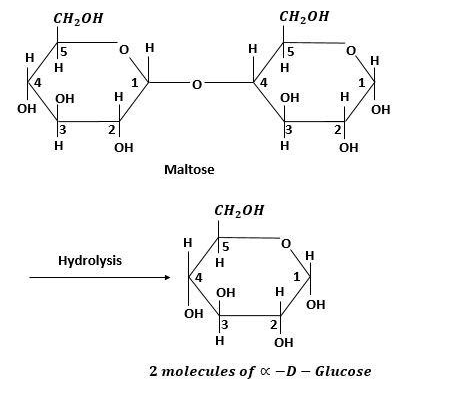Question
Question: Maltose on treatment with dilute HCl gives: (A) D-Galactose (B) D-Glucose (C) D-Glucose and D-...
Maltose on treatment with dilute HCl gives:
(A) D-Galactose
(B) D-Glucose
(C) D-Glucose and D-Fructose
(D) D-Fructose
Solution
Reaction with dilute HCl is hydrolysis reaction so hydrolysis of maltose should be done. Hydrolysis is done in the presence of water or dilute acid.
Complete answer:
Reaction of Maltose to glucose is:
C12H22O11+H2Omaltose2C6H12O6
Maltose C12H22O11 is a disaccharide. Disaccharides are carbohydrates which on hydrolysis give two same or different monosaccharides. They are made up of two molecules of monosaccharides linked to each other by condensation reaction. During condensation reaction one molecule of water is eliminated.
Monosaccharides units are linked to each other through oxygen atoms by a bond called glycosidic linkage.
One mole of maltose on hydrolysis gives two moles of α−D− glucose.
Maltose is composed of two α−D− glucose units which are condensed together through C1 of one unit and C4 of other units. Both glucose units are in pyranose form.

In hydrolysis it breaks at C1 and C4 positions and forms α−D− glucose.
Additional information: Condensation reaction: It is a reaction in which two molecules combine to form a larger molecule while leaving water or other smaller molecule as a byproduct.
Hydrolysis: It is the chemical breakdown of a compound due to reaction with water.
Monosaccharides: They are simple sugars which contain one oxygen and two hydrogen atoms for each carbon atom present in the compound.
Note: In organic chemistry, reaction with mineral acids like dilute H2SO4, dilute HCl is called hydrolysis reaction. Reaction with concentrated H2SO4 is called dehydration reaction. They do not form sulphates or chlorides.
